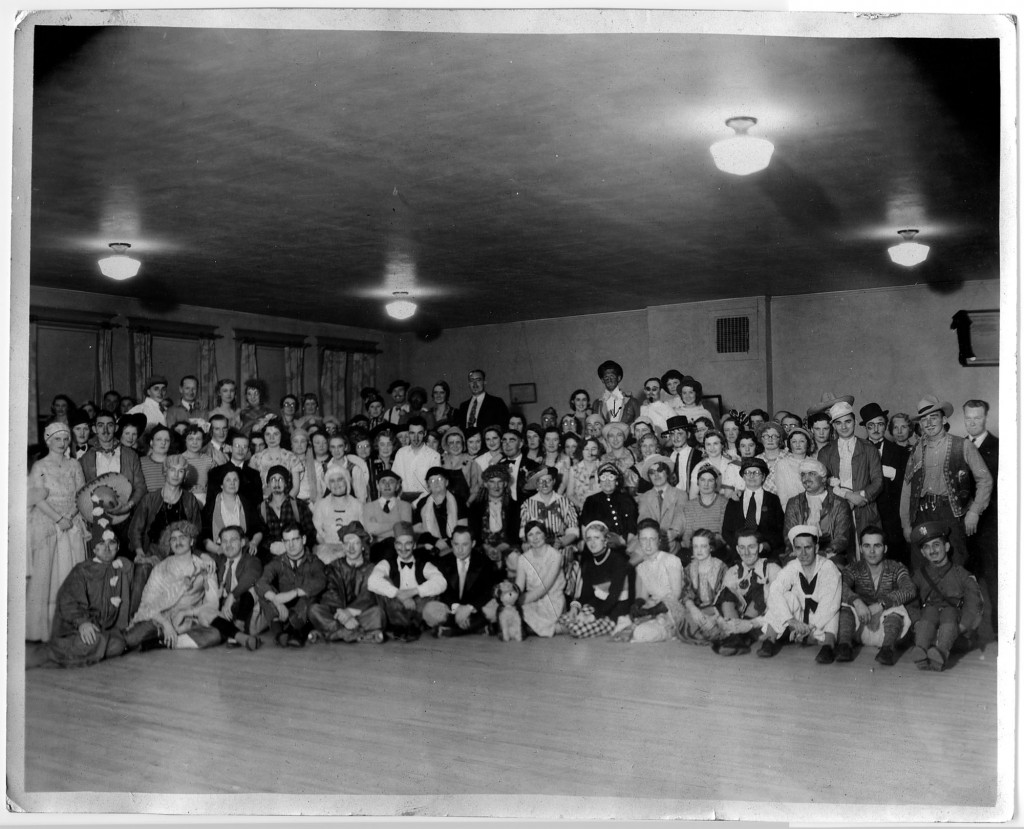Happy Halloween from Black’s Department Store! This wasn’t the store located in the Black Building: the photo was taken in 1932, so this ragtag bunch of costumed employees worked for the Store Without A Name, Black’s followup to his original department store. Sure, the photo was taken in November, but you can’t always plan your costume balls around a holiday like Halloween. As seen in last Sunday’s Dakota Death Trip, but you can click the photo for a much larger view: see if you can find the one person marked with an arrow!
Tag: fargophilia
Red River Flood, 1952.
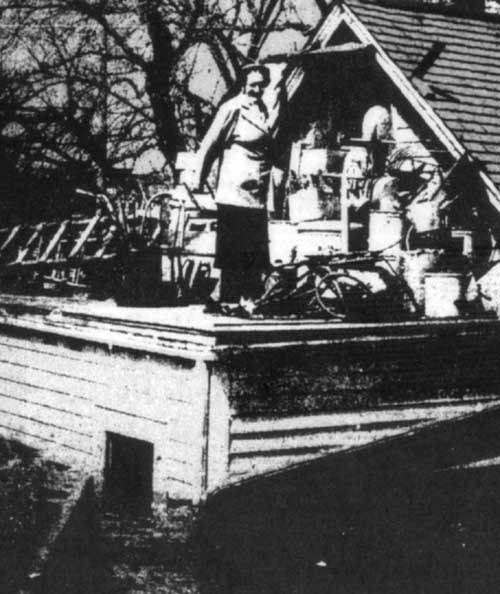
Click for full image
Mrs. Colin Campbell would not be ousted from her home: she is standing on the roof of her back porch, after climbing out a second story window. The water is about 4 feet away from covering her feet, but she was non-plussed; in the accompanying article, she defied police attempts to evacuate her, declaring it was a good time to catch up on her embroidery. On April 16, 1952, the Red River crested at around 35 feet; a USGS paper declared it the highest crest since 1897. Her address, 106 1st Avenue South, no longer exists; Urban Renewal wisely razed the neighborhood south of Main and east of 4th street, which was regularly subject to inundation even in light flood years.
Red River Flood, 1897.
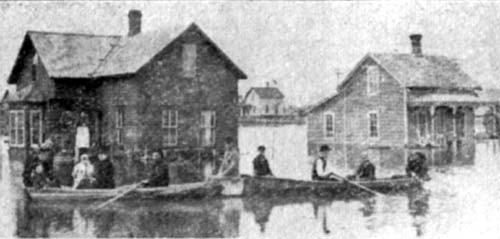
Click for full image
Broadway and NP, 1970s.
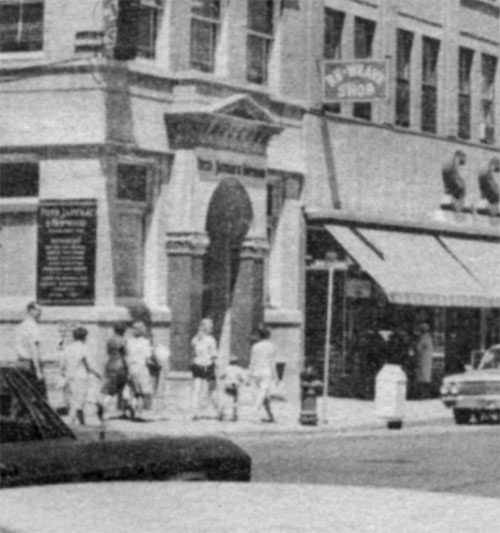
Click for full image
The corner of Broadway and NP Avenue, looking north, in downtown Fargo. Early 1970s.
Jerry “Killer” Meeker, 1945.
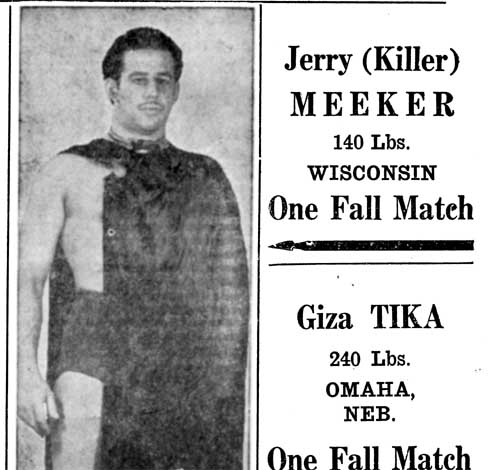
Click for full image
Professional wrestler Jerry (Killer) Meeker, from an advertisement for an appearance (with others) in Fargo, ND, 1945.
Scenic North Dakota Winter, 1930s.
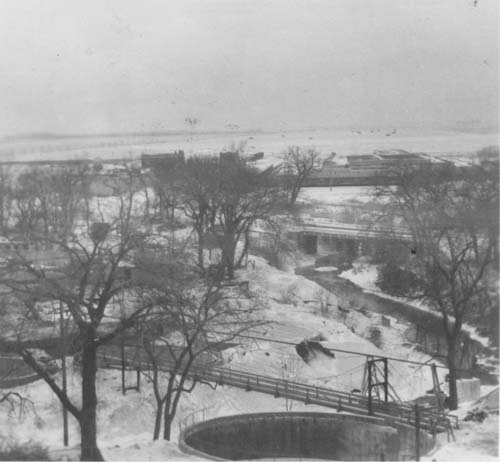
Click for full image
NDSU’s Downtown Expansion
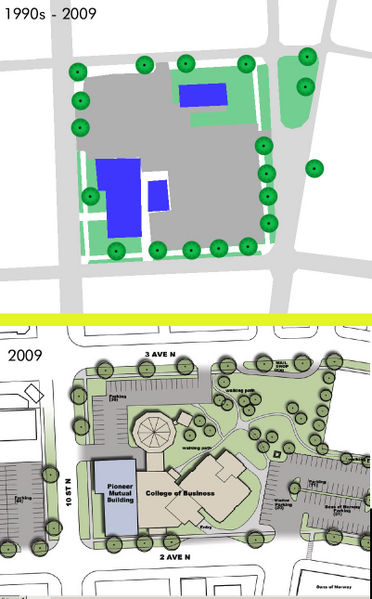
I hadn’t realized this when I was going over NDSU’s PML Building expansion: the Y-shaped section of 9th St North directly behind the building will be adsorbed into the NDSU Downtown campus. The wedge of green houses six mailboxes (due to one-ways it allows drivers to drop their mail off out the car window), several trees and a flower garden, and the Statue of Rollo. It appears that Rollo will stay on the grounds, and an accommodation for the mail drop will exist on 3rd Avenue (a one-way going East). I’m pleased with two things: an increase in downtown green area, and a reduction in downtown parking lots. Even when the PML building was completely occupied, the lot was rarely full – remember, the lot across the street to the west also belongs to the PML building as well. If there’s one thing I hate about downtown Fargo, it’s too many parking lots, not enough buildings. I don’t like the loss of a downtown street, though; several other north-south streets have been closed off in the past few years due to building expansion and train safety.
Pipe Gang, 1937.
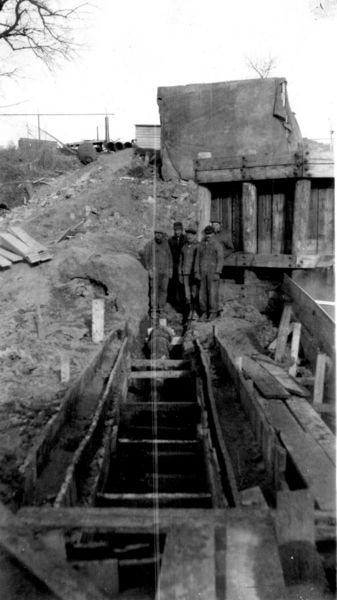
The “Pipe Gang” (closeup here), during construction of the West Fargo Armour Meat packing plant sewage treatment system, taken December 4, 1937.
Cinerama-70 in Fargo
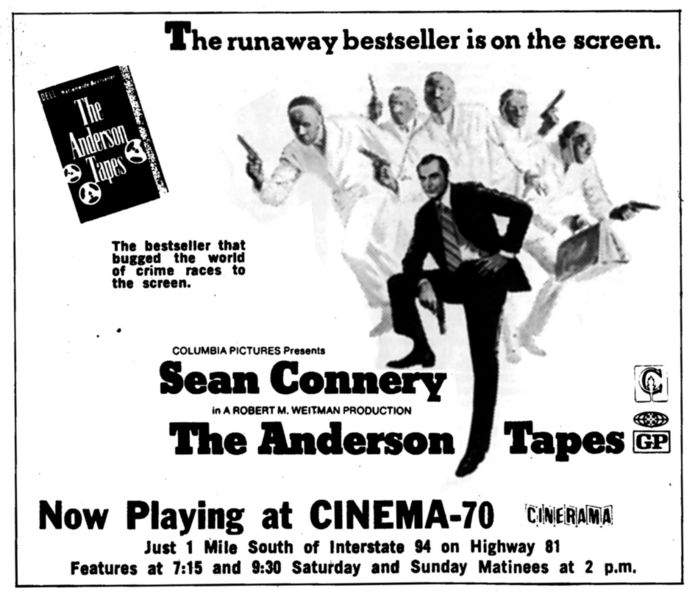
I don’t remember the Cinema-70, but by the time I was old enough to become a moviegoer it had changed to a 3-screen, 35mm multiplex like all the rest in town, where I had to sit on my mom’s lap for Return of the Jedi because it was so full. The theatre closed shortly after, and sat vacant for a decade, until it was torn down and turned into a parking lot for the gym next door.
In 1971, however, it was a single-screen “Cinerama 70” theatre. In the 1960s, whoever built the theatre banked on the belief that Cinerama, the wide-aspect-ratio film style popularized in the late 50s and early 60s, would be there to stay. By the 1970s Cinerama was rarely used, few studios even had equipment to film in it, and it had been bastardized from the original 3-camera setup to an anamorphic widescreen format. The Anderson Tapes was filmed on standard 35mm film with a normal aspect ratio, which left over half of a Cinerama screen unused. It’s no wonder the theatre broke up their one-room schoolhouse into a three-screen theatre.
On the right-hand side of the ad, it looks like a typo, but not really: 1971 was in some of the early years of the MPAA’s voluntary film rating system. “GP” was the replacement for the “M” rating, when people found the “M” and “R” ratings too hard to tell apart. “GP” meant, essentially, what “PG” means today, but too many people thought it meant “general public”, thus confusing it with the “G” rating. There was just a narrow 2-year window when “GP” was used.
The Red River Mall
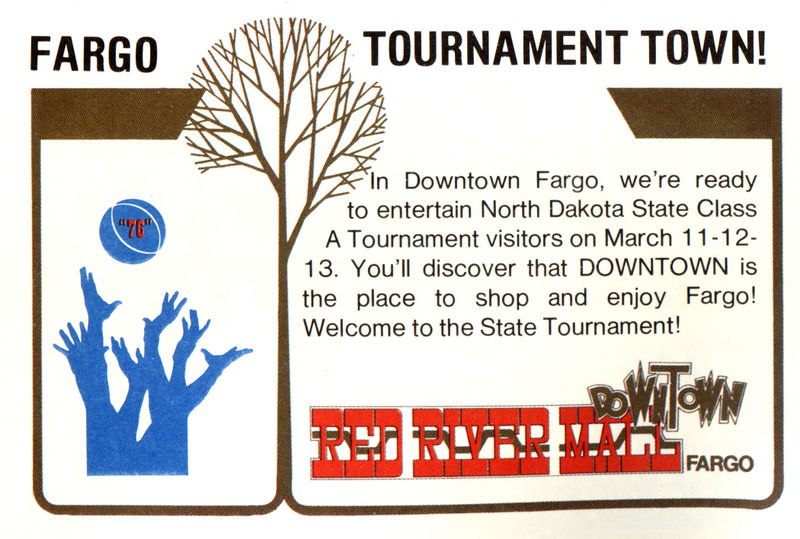
I remember the “mall” from my youth, but it barely registers that it ever actually had a name. The Red River Mall was a misguided attempt to revitalize Fargo’s downtown, which (whether directly or indirectly) led to downtown Fargo’s near-collapse in the late 80s and early 90s, and forcing the renewal plans that threaten to cause another Red River Mall-like slump.
In the 1960s and early 1970s, the nationwide Urban Renewal movement hit Fargo and Moorhead: Moorhead got an actual indoor mall to replace the dozens of retail stores and apartments downtown. Fargo got tall buildings, open spaces, and the Red River Mall. The Mall wasn’t a direct knee-jerk reaction to the creation of the West Acres Mall, but it was hoped to counter the movement of stores away from the downtown area. Fargo’s retail center stretched from around 8th Avenue north to 5th Avenue South, and extended east to around 2nd Street and west to 10th Street. Modern Fargoans may be wrinkling their brows at this range, wondering how downtown Fargo was ever that big: today, Downtown starts at 6th Avenue and stops at Main, and barely extends a block off Broadway. The rest of those buildings? They were replaced by modern office buildings, they burned and were paved over instead of rebuilding, they were sacrificed in favor of flood protection, they were demolished to create parking lots, and they got absorbed by their neighbors.
So, by the early 1970s, Downtown Fargo was in a poor position: it had a number of department stores, but its retail influence was shrinking. Small malls were popping up at the edges of town where new houses were being built. And then, West Acres gave the department stores the final boost to move out.
That left large, empty buildings, struggling locally-owned stores, and a loss of shoppers. The city, in its infinite wisdom, saw the possibility of turning Downtown Fargo into something akin to Nicollet Mall in Minneapolis.
Here’s how the plan went: Broadway, formerly two lanes with parking along all sides, would be turned into a winding, parking-less, snake-like street emulating the curvy nature of the Red River. Keeping to the curvy road, large cement pylons would mark the borders. To appeal to pedestrians, at their appropriate places along the “river”, marble place-markers represented the border cities. To keep rain and snow off pedestrians, overhanging roofs would line the street close to the buildings. Trees remained, or were planted for aesthetic reasons, with nice sitting places scattered throughout.
As you might guess, with the loss of large stores shoppers weren’t going downtown much, and now that Broadway was difficult to navigate they were less likely to do so. Sidewalk ceilings helped some, but weren’t enough encouragement. The Red River Mall eliminated a lot of downtown parking, which caused more buildings to disappear from along the streets, further reducing retail spaces in exchange for mostly-empty parking lots.
In 1976, optimism was still high: the Red River Mall was still an attraction. It was only a year or two after West Acres’ debut, so there was less evidence of replacement, as opposed to an expansion of retail opportunities. Downtown stores hoped that regional events like the basketball tournament would draw shoppers to our repackaged ‘shopping mall’ and stop by. Eventually, it became clear that the Red River Mall was nothing more than shiny wrapping paper on an unwanted, regifted chotchke: even its name slowly dropped out of popular use, and Broadway’s retail influence all but stopped.
